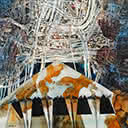Manihera's Family c.1950 - 51
69.2 x 74.6 cm
est. $100,000 - 150,000
PROVENANCE The Sutch - Ovenden Collection, Wellington
EXHIBITED Canterbury Society of Arts, Durham Street, Christchurch, 1951, No. 46 New Zealand Academy of Fine Arts, Wellington, 1951, No. 237 Russell Clark 1905 - 1966: A Retrospective Exhibition, Robert McDougall Art Gallery, Christchurch, 1975 National touring exhibition: Dunedin Public Art Gallery, Dunedin, Aigantighe Art Gallery, Timaru, Bishop Suter, Nelson, Hawkes Bay Art Gallery & Museum, Napier, Gisborne Art Gallery & Museum, Gisborne, National Art Gallery, Wellington, Manawatu Art Gallery, Palmerston North, Sarjeant Art Gallery, Wanganui, Govett-Brewster Gallery, New Plymouth, Waikato Museum & Art Gallery, Hamilton, Auckland City Art Gallery, Auckland
ILLUSTRATED Russell Clark, Retrospective Exhibition, Robert McDougall Art Gallery, 1975, p.41
One of the most important artists of his generation, Russell Clark worked first in advertising and as a commercial illustrator while building a reputation nationally as a painter by exhibiting with art societies and mounting solo shows. During World War II he was an Official War Artist in the Pacific. After the war, he had a twenty-year career as a popular lecturer at the Canterbury College School of Art in Christchurch where he had earlier studied from 1922-1927. By the late 1950s he had segued into modern sculpture, creating memorable works such as the anchor stones outside the Bledisloe Building in Auckland. His experimentation in three dimensions was cut short by an early death in 1966 at age 61. Nine years later, a retrospective exhibition of 70 works (including this one) toured to 12 galleries nationally. In the same year, 1975, the New Zealand Library Association established the Russell Clark Award for children's book illustration in his memory.
The latter commemorative award is due to Clark being not only the illustrator for the New Zealand Listener from when it started in 1939, but also for the School Publications Branch of the Department of Education. In 1949 he was commissioned to illustrate a Primary School Bulletin about life in Ruatāhuna, an isolated settlement in Te Urewera halfway between Rotorua and Wairoa where Māori was still the first language. He described it as fine country. Journeying there from Christchurch, he quickly completed preparatory drawings both for his Bulletin illustrations and later paintings such as this one. A companion piece, Old Keta (1949) depicting a thoughtful kuia seated and smoking a pipe, is now in the Museum of New Zealand Te Papa Tongarewa collection. The subject here is the whānau of kaumātua Dan Paratene Manihera (1886-1966) who brought up his two sons and five daughters on his own after his wife Raha Ere Ruru died in 1940. He is shown as the largest figure, dressed in a blue shirt and brown trousers with braces. In contrast to his children who are all barefoot, he wears shoes. Standing, he stretches out his arms, drawing his disparate whānau together and gesturing towards the wharenui Te Whai-a-te-Motu in the distance. Clark has aligned the house's gable underneath the dark form of Maungapōhatu, the sacred mountain of Ngāi Tūhoe. It is an engaging image because the figures are pushed towards the viewer in the foreground, with an old tea chest placed behind them, leading the eye towards the whare. This meeting house is illustrated by Clark in the 1950 Primary Schools Bulletin which also includes short stories by two of the children depicted here: A Concert by Hannah Manihera (who would have been 15 years old in 1949), and Potato Planting by Milly Manihera. A narrative is implied; perhaps the figures have paused in their harvesting of potatoes in summer to attend an important event in the meeting house?
The late William Ball Sutch who originally owned this painting, was a great admirer of the artist's work. In his review of Clark's Centre Gallery exhibition in Wellington in 1954 he was impressed by how Māori subjects were treated with respect: Here is no sentimentalised tourist view of the Māori. Here certainly is the fun and the animated talk on the marae, but there is also the sombre resignation, the dignity of the women and the social strain put upon the Māori race by the white man's alleged civilisation. If Russell Clark's only contribution had been his Māori studies, he would have been known in the history of New Zealand art as the man who gives us eyes to see the Māori.
LINDA TYLER





